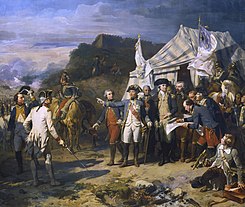
Landing of a French auxiliary army in Newport, Rhode Island on July 11, 1780, under the command of Comte de Rochambeau
Expédition Particulière was the code name given by the French government for the plan to sail French land forces to North America to support the American rebel forces against Britain in the American Revolutionary War. In English it was known as the Special Expedition.
The expedition, 5,000 strong, arrived in America in July 1781. A second wave of 2,500 was intended to join them but was unable to escape the British blockade of Brest. After remaining inactive for almost a year, Rochambeau marched his troops south to rendezvous with George Washington's Continental Army for a planned attack on New York City. At Rochambeau's urging, Washington abandoned the planned attack and instead they moved into Virginia to join with the French fleet of Admiral François de Grasse to trap Lord Cornwallis's British army at Yorktown, forcing its surrender in October 1781.
After wintering in Virginia, the army returned northwards the following year. Rochembeau rejected several proposals for moves against other British positions and in late 1782, the army sailed for the West Indies.
Background[]
France had been in contact with colonial radicals as early as 1774. In January 1776 France began sending large amounts of covert financial aid and military supplies to the American rebels. Following the loss of a British army during the Saratoga Campaign of 1777, France signed a Treaty of Alliance recognising American Independence in February 1778. This established the Franco-American Alliance. A French fleet under Charles Hector, comte d'Estaing, sailed out to co-operate against the British, and was widely expected to help bring a swift end to the war.
The initial attempts to seek victory were beset by problems. An operation against Newport miscarried in 1778, the following year, the Franco-American Siege of Savannah ended in defeat. D'Estaing and his ships then sailed for home, with relations between the allies severely strained.
Arrival in America[]
On February 2, 1780, the council of King Louis XVI formally approved the Expédition Particulière to send French military and naval forces to America.[1] A French fleet under Admiral de Grasse crossed the Atlantic and landed at Newport, Rhode Island on July 10, 1780 with General Rochambeau and 6,000 French troops to support the Continental Army under George Washington.[2]
Yorktown campaign[]

Siège de Yorktown by Auguste Couder, c.1836.[3] Rochambeau and Washington giving their last orders before the battle.
In July 1781, Rochambeau's army left Rhode Island and marched across Connecticut to join Washington's army on the Hudson River at Dobbs Ferry, New York. From there the combined forces marched overland to Virginia. During this time, Admiral de Grasse managed to defeat a British fleet sent from New York City to evacuate British General Charles Cornwallis at the Battle of the Chesapeake on September 5, trapping Cornwallis on the Yorktown peninsula. On September 22, Rochambeau and Washington combined forces with those of Marquis de Lafayette and began the siege of Yorktown. The siege ended with the surrender of Cornwallis on October 19, 1781.[4]
Departure to the West Indies[]
Rochambeau's force spent the winter in Virginia. The following year they moved north towards New England. Washington again tried to interest Rochambeau in an attack on New York City, Charleston or Canada but the Frenchman rejected the proposals. Orders instead arrived for his expedition to go to the West Indies and in late 1782 it sailed from Boston for Port-au-Prince. However, by then the Peace of Paris had been agreed and the planned 1783 campaign in the Caribbean never took place. In late April they began sailing for home, reaching Brest and Toulon in June and July 1783.[5]
Legacy[]
The Expedition has been described as the only substantial force of foreign allies ever to serve on United States soil for an extended period.[6]
References[]
- ↑ Kennett, Lee (1977). The French Forces in America, 1780-1783. Greenwood Press, Inc. Page 10.
- ↑ From Yorktown to Valmy Samuel F. Scott p.6.
- ↑ Conserved in the Galerie des Batailles, Château de Versailles, France. A copy is displayed at the Yorktown National Park Visitors' Center, Yorktown, Virginia.
- ↑ Lengel, Edward (2005). General George Washington. New York: Random House Paperbacks. p.342.
- ↑ Scott p.109-110
- ↑ Scott p.3
External links[]
The original article can be found at Expédition Particulière and the edit history here.